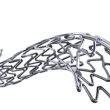Individual randomized studies have shown variable results regarding the mortality risk following treatment of left main coronary artery disease (LMCAD), either through percutaneous coronary intervention (PCI) or coronary artery bypass grafting (CABG). However, upon assessment of the latest meta-analyses (with matched data), similar risks of all-cause and cardiovascular mortality have been reported for both groups....
Should We Treat Obstructive Coronary Artery Disease in TAVI?
Coronary artery disease, both obstructive and non-obstructive, often coexists with significant aortic stenosis. Therapeutic decision-making in this scenario remains controversial, not only regarding the need for treatment, but also about when it should be addressed, considering its pros and cons. Various analyses have yielded contradictory data, as most lesions are chronic and stable. Currently, the...
Coronary Artery Disease in TAVR: Unsolved Dilemma
Aortic stenosis shares risk factors with coronary artery disease (CAD), and its prevalence varies according to age, reaching approximately 50% or more in some registries. Deciding when to treat and the need for percutaneous intervention presents a challenge. It has been established that epicardial stenosis at proximal level, or the medial segment, requires intervention, especially...
EASTBOURNE Registry: Use of Sirolimus-Coated Balloons in Coronary Artery Disease
The introduction of drug coated balloons (DCB) has become an innovative therapeutic alternative to current treatments. Paclitaxel-coated balloons (PCB) have been used to treat in-stent restenosis (ISR) and also approach CAD in native arteries. More recently, sirolimus-coated balloons (SCB) are being looked at as part of pilot studies and smaller registries with preliminary results. The...
Diffuse Coronary Artery Disease: One-Year 48mm XIENCE Skypoint Outcomes
Long 48mm Stent XIENCE Skypoint in the treatment of diffuse CAD Long coronary artery lesions often involve complex decision making since they can be treated either with a long stent or with shorter overlapping stents. Both in registries and meta-analysis, the overlapping technique has been associated to increased target vessel revascularization and increased radioscopy time,...
Clinical Impact of Coronary Artery Disease on Results After TAVR
Coronary artery disease (CAD) coexists with aortic stenosis in about half the patients who suffer the latter. These patients receiving antiplatelet therapy are at a higher risk of periprocedural bleeding—one of the most frequent complications in patients who undergo transcatheter aortic valve replacement (TAVR). One way of limiting the risk for bleeding is choosing the...
ACC 2023 | YELLOW III Study. Effect of Evolocumab on Coronary Plaque Characteristics in Stable Coronary Artery Disease
Dr. Kini presented the results of the YELLOW III Study where she analyzed the effect of evolocumab on coronary plaque in patients with stable coronary artery disease. The study included 137 patients who underwent coronary angioplasty to the culprit vessel and endovascular imaging (OCT, NIRS/IVUS) to non-obstructive lesions (30%-50%). If their plaque was lipid-rich (defined...
Do Symptoms and Quality of Life Differ between Focal and Diffuse Coronary Artery Disease?
Changes in fractional flow reserve (FFR) values after percutaneous coronary intervention (PCI) are associated with improvement in angina symptoms. The pattern of baseline coronary artery disease influences the degree of variation in FFR after stent implantation. Focal coronary artery disease leads to high post-PCI FFR values, while the improvement is not as marked in diffuse...
Coronary Physiology Is Useful in Chronic Kidney Disease
Coronary physiology, FFR and iFR, has been shown safe to defer lesions and effective to save stents by different randomized studies and registries. However, patients with chronic kidney disease have not been thoroughly analyzed yet, which brings us to the question about what to do in the face of their negative evolution, when atherosclerosis develops...
Prognostic Value of Structural and Functional Microvascular Dysfunction in Patients with Nonobstructive Coronary Artery Disease
Coronary microvascular dysfunction (CMD) is a paramount factor involved in the development of anginal syndromes. Among patients with angina and nonobstructive coronary artery disease with CMD, two patterns have been identified using minimal microvascular resistance: structural CMD, and functional CMD. Structural CMD is characterized by decreased coronary flow reserve (CFR) in the presence of increased...









